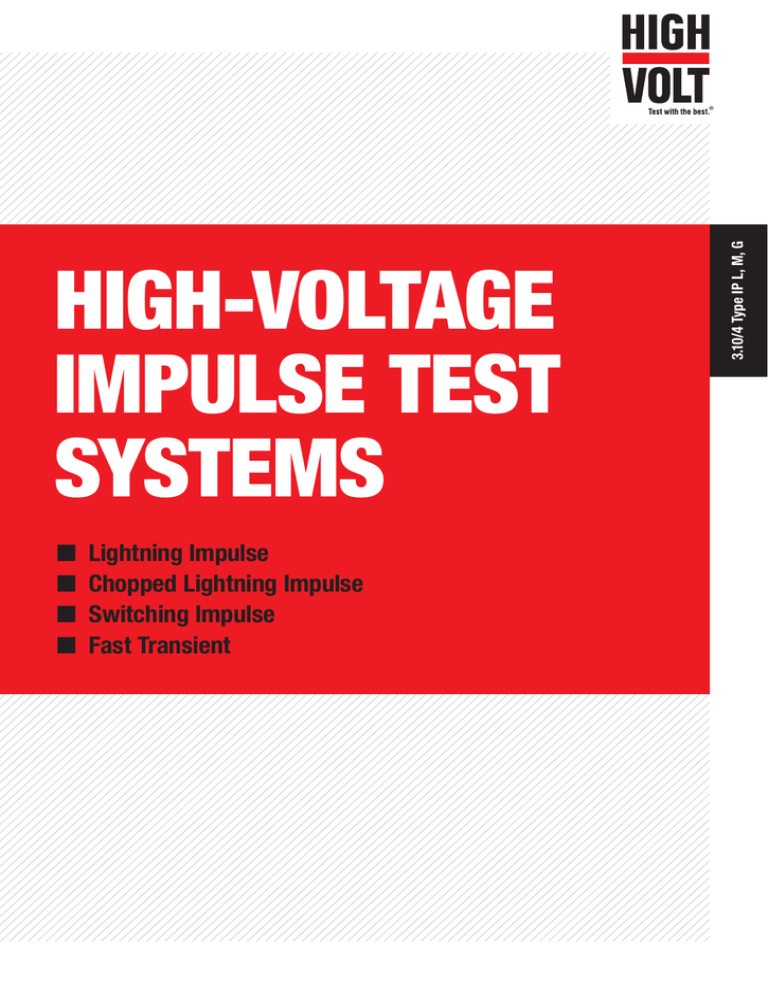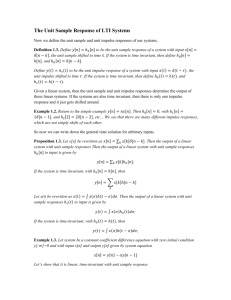n Lightning Impulse n Chopped Lightning Impulse n Switching
advertisement

n Lightning Impulse n Chopped Lightning Impulse n Switching Impulse n Fast Transient 3.10/4 Type IP L, M, G HIGH-VOLTAGE IMPULSE TEST SYSTEMS HIGH-VOLTAGE IMPULSE TEST SYSTEMS 1 2 9 12 Fig. 1 Impulse voltage test system series G with Connection Point Fig. 2 Impulse voltage generator series M facts IN BRIEF APPLICATION Impulse test systems generate high artificial impulse voltages that model transient overvoltage wave shapes occurring in the power grid. The impulse voltage test systems are applied to test the ability of equipment for the power grid to withstand transient voltage peaks, such as those resulting from lightning strokes or switching. Main applications for lightning impulse voltages are: Routine tests for power transformers and bushings (full and chopped impulses) Routine tests on surge arresters Sample tests or type tests for medium or high voltage cables Type tests on GIS HIGHVOLT offers three series of impulse test systems: Series L for medium voltage applications designed as a simple and robust system for the demands of production test bays for large numbers of specimens, with easy operation Series M for higher medium voltage and high voltage designed as an effective solution for routine and type test bays. This series is easily extendable. Series G for extremely high test voltages and test power, with easy handling by such as an inner ladder and platforms, encapsulated spark gaps and resistor storage at each stage. It is designed as high end test system for all applications from routine testing to research. All series are equipped with our MIAS® impulse analyzer. It complies with or exceeds all relevant IEC and IEEE standards. For higher rated voltage levels also tests with switching ­impulse voltage have to be made. Furthermore, the impulse voltage test systems are also able to generate fast transient impulses. All test procedures are in accordance with the ­relevant IEC and IEEE standards. BENEFITS OF IMPULSE TEST SYSTEM n DESIGNED FOR LOW INDUCTANCE OF IMPULSE GENERATOR n ULTRAMODERN IMPULSE MEASUREMENT AND CONTROL SYSTEM MIAS® n INTEGRATED SOFTWARE SOLUTION FOR DATA EVALUATION n EASY EXCHANGE OF DAMPING AND TAIL RESISTORS ESPECIALLY FOR SERIES G Power supply 3 4 Test Object 15 5 7 8 12345 10 U (t) 14 13 11 Power connections Communication / measurement 1 Control unit 2 Charging unit HV circuit 3 Impulse generator 4 Impulse voltage divider/basic load capacitor 5 Chopping gap 6 Overshoot compensation 7 Connection Point 8 Impulse current shunt Control system 9 Operator device 10 Industrial computer 11 Remote access module 12 Ethernet/PROFIBUS 13 LAN, Internet Measuring system 14 Transient measuring system, connected via fiber optic link 15 Transformers, bushings, surge arresters, GIS etc. Fig. 3 Block diagram of impulse voltage test system SYSTEM AND COMPONENTS The impulse generator (3) is charged by the charging unit (2), which is connected via the control unit (1) to the power supply [see fig. 3]. The impulse voltage divider (4), which is capacitive damped, measures full and crest-chopped lightning and switching impulses. The chopping gap (5) provides the fast ­voltage breakdown. The overshoot compensation (6) improves the ­impulse voltage wave shape for highly capacitive test objects. The voltage measuring system is completed by a transient ­recorder (14). The test system is operated by an industrial ­computer (10), which is connected via an optical Ethernet cable (12) to the control unit and additionally by the operator ­device (9) that is connected via an optical PROFIBUS system (12) to the control unit. In addition the trigger signals for the generator are supplied via optical links. All this guarantees an operation free from interferences. An integrated software solution provides semi-automatic and fully automatic operation of even complex test procedures, data storage, and generation of test reports. The Connection Point, CP (7), is an innovative patented solution that fulfils the following functions: Measuring of all relevant testing wave shapes lightning impulses (LI) 1.2 / 50 μs, chopped lightning impulses (LIC), switching impulses (SI) 250 / 2500 μs and AC voltages Chopping of lightning impulses, and Compensation of overshoots The CP integrates impulse voltage divider, chopping gap, and overshoot compensation into one device. If one component is not required, the CP can also be implemented in a reduced configuration. Thanks to its compact design, the CP requires less floor space. Furthermore, the chopping gap does not need to be disconnected when changing from LI / LIC to SI, which leads to a time saving test procedure and easy handling. Moreover, one high voltage connection (between chopping gap and test object) is omitted, resulting in a lower inductance of the test circuit. The overshoot compensation covers a wide load range of test objects without any modification. BENEFITS OF CONNECTION POINT n EASY HANDLING / TIME SAVING n SPACE SAVING DESIGN n LOW INDUCTIVE TEST CIRCUIT n ONE OVERSHOOT COMPENSATION FOR ALL TEST CASES HIGH-VOLTAGE IMPULSE TEST SYSTEMS TECHNICAL PARAMETERS / BACKGROUND For distribution transformers, cables and other devices in the medium voltage range: Impulse test system of series L Lightning impulses up to approx. 1000 kV Switching impulses up to approx. 850 kV Impulse test systems and additional components for special applications are also available, for example for University and research labs: Entire range of voltage levels for different applications Adapted resistor sets for special wave shapes For power transformers, cables and other devices up to approx. 230 kV: Impulse test system of series M Lightning impulses up to approx. 2200 kV Switching impulses up to approx. 1700 kV Mobile impulse testing: System installed on trailer with self-raising system Mobile control system installed in air conditioned container Up to 2200 kV charging voltage For power transformers, cables and other devices up to extremely high voltage ratings: Impulse test system of series G Lightning impulses up to approx. 5000 kV or more Switching impulses up to approx. 3000 kV or more GIS testing: Special inductors for generation of oscillating lightning and switching impulses Overshoot compensation HIGHVOLT impulse generators have a low inductive design. In comparison with a traditional impulse test system with a separate divider and chopping gap, the circuit inductance is further reduced due to the compact design of the Connection Point. Impulse tests with peak voltages higher than UP = 2000 kV require longer dielectric distances between the components of the test circuit. The effective parasite inductance of the entire test circuit is not negligible under the assumption that the connections between the test circuit components have a specific inductivity of L = 1 μH/m. An overshoot with a value of more than ´= 5 % can appear, depending on the load of the test object. An additional overshoot compensation, which is integrated into the chopping gap, reduces the overshoot and allows the test of high capacitive load by maintaining the allowed overshoot and the permitted front time T1. The overshoot ´ is explained in IEC 60060-1. Combined voltage testing: Phase controlled triggering of the impulse generator Ch1 test setup with overshoot compensation Ch2 test setup without overshoot compensation [kV] 200 kV / div 2 µs / div For further information please contact: Ch1 Ch2 1600 1400 1200 1000 800 600 400 200 0 -2 Fig. 4 gives an example using CLoad = 5 nF and UPeak = 1800 kV for the effectiveness of the integrated overshoot compensation. The length of the example testing circuit is assumed using l = 25 m, and a parasite inductance of the test circuit of L = 25 μH. In practice the length depends on the detailed test bay arrangement. The lightning impulse without overshoot compensation (see red curve in fig. 4) results in an overshoot of ´ = 7.5 % and a front time of T1 = 1.66 μs and would be within the IEC tolerance. The overshoot compensation reduces the overshoot to under ´ = 5 % (see blue curve). Similar figures are yielded by other voltages and load capacitances. See the second example in table 1. CH1: 1000 MS / s 1800 0 2 4 6 8 10 12 14 16 18 Fig. 4 Example of overshoot compensation Table 1 Measured examples for overshoot compensation T1 in μs in % UPeak = 1800 kV / CLoad = 5 nF Without compensation 1.66 7.5 With compensation 1.52 4.2 Without compensation 1.74 8.5 With compensation 1.52 5.0 UPeak = 2400 kV / CLoad = 4 nF HIGHVOLT Prüftechnik Dresden GmbH Marie-Curie-Straße 10 01139 Dresden Germany © HIGHVOLT Prüftechnik Dresden GmbH – 2014/09 – 3.10/4.pdf – Subject to change without prior notice Phone Fax E-mail Web +49 351 8425-700 +49 351 8425-679 sales@highvolt.de www.highvolt.de [µs]

